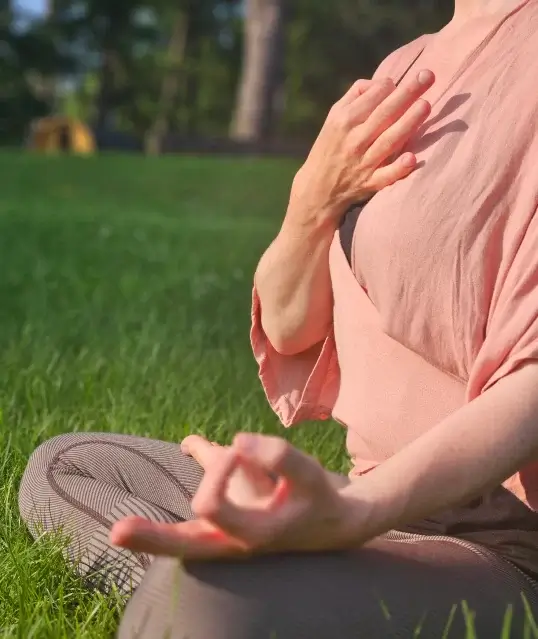


Pranayama, the art of conscious breathing, is a central element of the Ayurvedic and yogic healing tradition. The breath is not only considered as life energy (Prana) but also as a bridge between body and mind. With every conscious breath, we open a space for clarity, inner calm, and more emotional stability. In our Ayurveda Cure Center, we accompany this process mindfully so that Pranayama becomes an effective tool for your mental well-being. Some insights into further techniques can be found in Ayurveda Philosophy.
In the hectic everyday life, many people breathe shallowly, often unconsciously. This rhythm increases inner restlessness and brings body and mind out of balance in the long term. Pranayama addresses exactly this to restore balance.
The term itself comes from two Sanskrit words: Prana (the subtle life force that sustains us) and Ayama (control or expansion). So Pranayama means much more than just breathing. It is the conscious regulation and expansion of life energy. To create this harmony, the practice uses a cycle of three basic steps:
• Puraka (inhalation): The conscious intake of breath and fresh energy.
• Kumbhaka (holding): A moment of stillness in which the body can fully absorb the Prana.
• Rechaka (exhalation): The intentional release of used air, toxins, and mental stress.

Through this targeted breath control, the autonomic nervous system is harmonized, the body synchronizes, and a meditative state is created that promotes concentration and emotional stability. Ayurveda also describes that Prana must flow freely to maintain vitality, mental clarity, and emotional balance. When the breath gets stuck, the inner balance also gets stuck. Through regular practice of these three phases, such blockages gently dissolve and a deep feeling of calm arises. This is a holistic approach to strengthening life energy, which we explain in detail in our treatments.
Ayurveda and Yoga use many breathing techniques that create different effects on the mind and body. Some of the most popular and effective are:
• Nadi Shodhana (alternate nostril breathing): Harmonizes both brain hemispheres, calms the mind, and promotes emotional stability.
• Ujjayi breath: Warms the body, strengthens concentration, and gives deep inner presence.
• Kapalabhati: Activates metabolism, clears the mind, and helps release stagnant energy.
• Bhramari (humming bee breath): A calming technique that noticeably relaxes the nervous system and heart rate.
These breathing techniques work not only during the practice but also create a foundation for resilience and mental balance in daily life. More application ideas can be found in our healing methods.
The effect of Pranayama is now confirmed. Science and Ayurveda meet in fascinating ways:
• Stress reduction: Deep breathing activates the parasympathetic nervous system—the part responsible for relaxation.
• Improved heart variability: An important indicator of resilience and emotional stability.
• Cognitive clarity: Conscious breathing reduces mental scattering and improves focus and memory.
• Regulation of emotions: Breathing techniques act directly on the limbic system—the emotional center of the brain.
Thus, science confirms what Ayurveda has taught for thousands of years: the breath is a powerful tool for stabilizing the inner world.
Since every person has an individual Dosha (constitution) in Ayurveda, the breathing practice is also adapted accordingly:
• Vata: Calm, grounding techniques like Nadi Shodhana or gentle extended exhalations bring stability and reduce inner restlessness.
• Pitta: Cooling breathing forms like Shitali reduce heat, irritability, and pressure to perform.
• Kapha: Activating techniques like Kapalabhati or stronger Ujjayi breathing promote lightness, drive, and mental clarity.
Before your cure begins, our experienced medical team guides you through a detailed consultation. This way, you understand exactly which Dosha should be balanced and which breathing techniques support your inner harmony best.
A powerful breathing practice comes from mindfulness, not effort. For a stable start, we recommend:
Start gently: Begin with a few minutes daily—quality before duration.
Sit upright: A stable, relaxed posture allows free breath flow.
Warm up with gentle movements: Light mobilization or yoga prepares the body well.
Stay mindful: Observe your breath without forcing it.
Rest afterward: A few moments of stillness after practice intensify the effects.
More advanced breathing and body practices are presented in our Yoga & Therapy program.
In the Ayurveda cure, we combine traditional breathing techniques with modern therapeutic support. The calm nature, structured daily routine, and mindful guidance of our Ayurveda team create a space where Pranayama is not only taught but truly experienced. Many guests say that the breath finally “arrives” here, free, without pressure, without expectations.
Pranayama is a powerful path to more balance, inner peace, and mental stability. Through conscious breath control, you activate natural self-healing powers, harmonize the Doshas, and create deep access to your own center. In the Retreat Park Am See Nattika Ayurveda, we support you mindfully and individually so that the breath becomes a tool for your sustainable inner strength.
A traditional breathing practice that harmonizes the flow of energy, connects mind and body, and strengthens mental balance.
A traditional breathing practice that harmonizes the flow of energy, connects mind and body, and strengthens mental balance.
Yes, especially with professional guidance. Techniques are always adapted to your constitution.
Many people feel relaxed after just a few breaths. Long-term balance comes through regular practice.
Yes, because it regulates the nervous system and promotes deep relaxation.
Even 5–10 minutes daily can create sustainable positive changes.